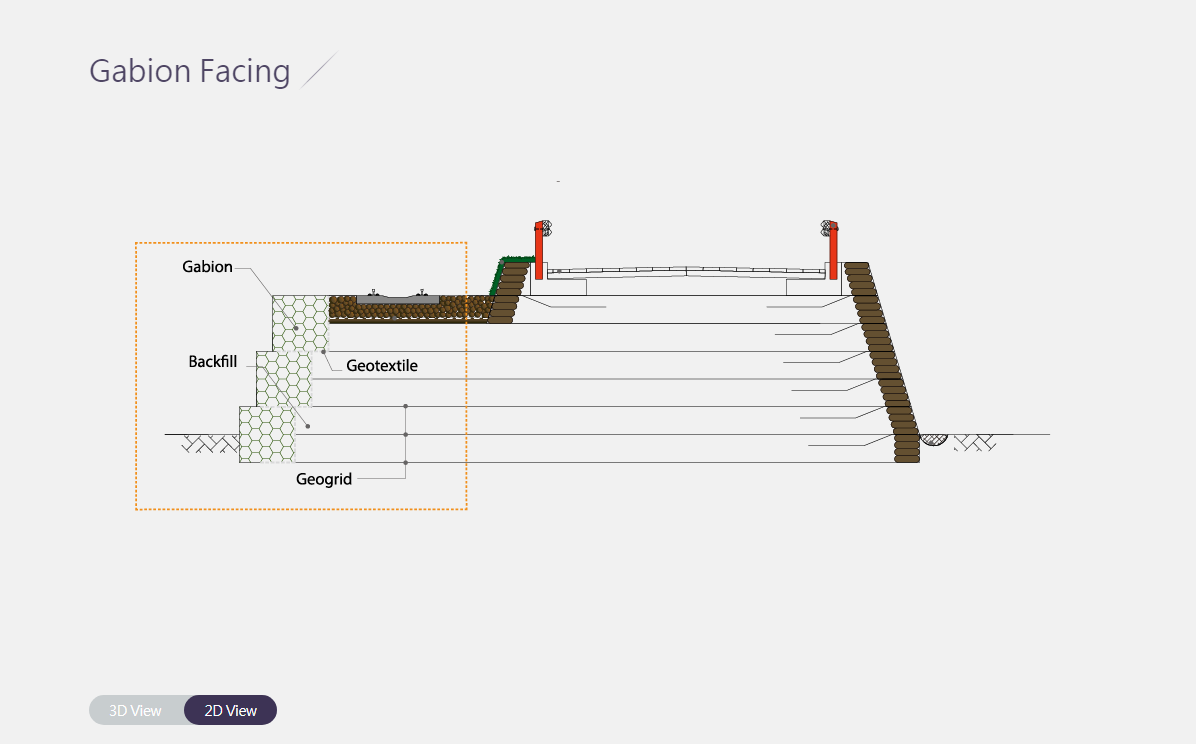
Gabion faced reinforced soil walls are a system when the structural stability is achieved by virtue of reinforcement layers of polymer geogrids or steel mesh. These polymer geogrids or steel mesh are placed in the soil linked to a facing skin of gabion.
Gabion Retaining Wall Description
What is a gabion basket retaining wall?
Gabion basket retaining walls are a system where structural stability is achieved by virtue of reinforcement layers of polymer geogrids or steel mesh. These polymer geogrids or steel mesh are placed in the soil linked to a facing skin of gabion. The gabion basket retaining walls are monolithic gravity mass structures that are well suited for erosion control applications and follow standard design practices for gravity and MSE retaining walls. gabion retaining walls do not require a concrete foundation. For heavier materials, double-wide foundation gabions can be used under the main structure to improve wall stability. As with the mass of gravity walls, the gabion face is inclined at 6 degrees to the vertical and/or stepped.
Reinforced Gabions Wall Cost: This type of structure costs less for walls 3 to 4m or more in height infill situations.
Mesh Sizes(mm) | Gabion dimensions and volumes | Wire diameter | ||||
L(M) | W(M) | D(M) | Capacity(m³) | The length of the reinforcement(M) | ||
80*100 100*120 | 2 | 1 | 0.5 | 1 | 2 | Mesh Wire: 2.5mm, 2.7mm, 3.05mm.2.5/3.5mm, 2.7/3.7mm |
3 | 1 | 0.8 | 2.4 | 3 | ||
4 | 1 | 0.8 | 3.2 | 3 | ||
2 | 1 | 1 | 2 | 3 | ||
3 | 1 | 1 | 3 | 3.5 | ||
4 | 1 | 1 | 4 | 3.5 | ||
Other specifications can also be customized processing.
● Some advantages of gabion walls are: easy to handle and transport
● Speed of construction
● Flexibility (gabions can withstand movement)
● Permeability (good drainage)
● Gabion baskets provide an easy-to-use method to reduce water velocity and protect slopes from erosion.
Applications of Gabion Retaining Wall
Slope Stabilization
Riverbank and Shoreline Protection
Road and Railway Embankment
Retaining Structures
Flood Control
Noise and Privacy Barrier
Landscaping Projects
Installation of Gabion Retaining Wall
Designers can select geogrids from a wide range of soil reinforcement systems to suit specific soil conditions including:
• Gabion faced soil reinforcement system using steel geogrids;
• Vegetating face slope reinforcement system using steel geogrids;
• Heavy-duty sheathed geogrids with strengths up to 1250kN/m for basal reinforcement and piled embankments;
• Polymer geogrids for slope reinforcement, segmental retaining walls and blockwork walls.


Retaining wall design takes into account site conditions, soil type, and loads above and behind the retaining wall. Larger gabion retaining wall solutions use thicker gabions at the base to distribute foundation loads and improve resistance to overturning and sliding.
When gabion retaining walls are subject to additional surcharges from driveways or other loads, designers are likely to increase the thickness of the gabions to handle the higher expected loads.
● Since gabion basket retaining walls are used in areas with high erosion potential, they must be constructed in a sequence so that they can be placed in place with as little delay as possible. The area where the gabions are to be placed should only be disturbed if the final preparation and placement can follow immediately after the initial disturbance.
● Where gabions are used for outlet protection, they should be placed prior to or in conjunction with the construction of the pipeline or channel so that they are in place when the pipeline or channel begins operation.
● Gabions should be inspected regularly and after each major storm event.
● All temporary and permanent erosion and sediment control measures shall be maintained and repaired as needed to ensure the continued performance of their intended function.
● All maintenance and repairs shall be performed in accordance with the approved manual.